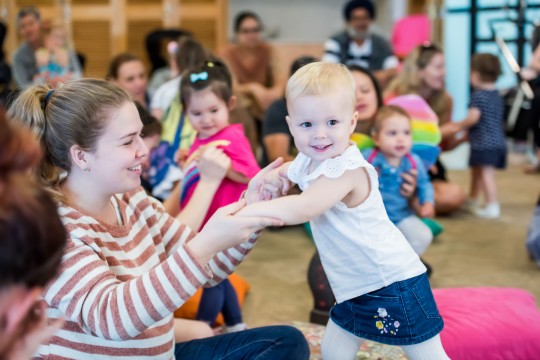
Share dance for many benefits
26 April 2022 | State Library of Queensland
International Dance Day is a global celebration of dance. Held on 29 April each year, the event strives to encourage dance participation through events and festivals held all over the world.
It’s never too early to turn on some music and share the joy of dance with your little one! Babies as young as 5 months old match body motion to music. You can encourage your little one to kick their legs to music at nappy time or hold them in your arms and dance around the room together to their favourite nursery rhyme.
A study based on babies aged between 5 months and 2 years old, found that humans may be born to move rhythmically in response to music. According to the findings, babies respond to the rhythm and tempo of music, and they find it more engaging than speech. Research also suggests that the better the children were able to synchronise their movements with the music, the more they smiled. Dancing stimulates almost every area of your baby’s brain, encouraging the growth of vital neurotransmitters.
Music and dance can be beneficial for older children too. Being exposed to music and different rhythms, and learning the moves all help brain development in the areas responsible for language, sound, reading, and speech. Take advantage of opportunities to get your child bouncing, marching, and tapping to the beat. All they need is a good tune and space to wiggle. If you haven’t got music to play, make your own with your voice and clapping hands.
Toddlers love a dance partner, so show them your best moves! Having fun and dancing together is a great bonding opportunity. Children are born mimics and love copying adults dancing and enjoying themselves. If you have a traditional dance in your family, teach children some of the moves. Not only will they get some great exercise, but they’ll be developing their listening and comprehension skills.
More than just rhythm
Children learn a range of skills from dancing including:
- Cognitive development including problem solving, memory, imitation, and abstract thinking
- Getting a feel for rhythm
- Limb and hand-eye coordination
- Gross and fine motor skills
- Spatial awareness
- Balance
Ways to add to the dance experience
Props:
- Dress-up clothes like swirly dresses, lycra, scarves, fabric pieces, ribbons, handheld instruments, percussion, bells and other things that encourage movement
- Make your own shaker instrument filled with rice or beans to keep the rhythm
Songs:
- Hokey Pokey
- I’m a Little Teapot
- If You’re Happy and You Know it
- Baby Elephant Dance
- Grand Old Duke of York
Dance activities to try at home:
- Play a variety of music for children to dance to.
- Talk to children about the music and their dance and help build their vocabulary. Dance words include 'fast', 'slow', 'spinning', 'clapping', 'pirouette', 'stamping' and 'turning'! You can also talk about position such as right, left, near, apart, and tempo including faster and slower.
- Play a game with some fun music with varying tempos and call out animal names. Encourage children to adopt the movements and poses of each creature.
- Get grandparents involved and waltz, Samba, Irish jig, or Haka together.
Books on a dance theme
Visit your local public library online or in person to see what books they have on dance. Your library may have some of these or other great titles.
- Baby Dance by Katrina Germain
- Bila's Big Dance by Rebbeca Chapman
- Can You Dance? by Sally Morgan
- Dancing Larry by Daniel Manus Pinkwater
- Dinosaur Dance by Sandra Boynton
- Giraffes Can’t Dance by Giles Andreae
- Leaping Lola by Tracey Hawkins
- Luna Loves Dance by Joseph Coelho
Dancing is an exciting and exhilarating physical activity. So, whatever dance or music your child enjoys, make it memorable. They are learning so much more than just how to move and the benefits will last a lifetime.
Comments
Your email address will not be published.
We welcome relevant, respectful comments.